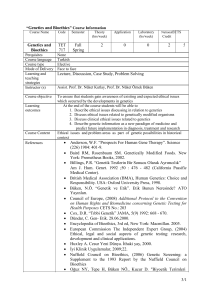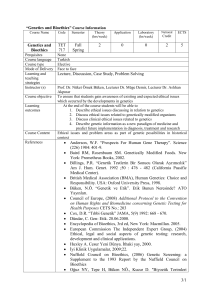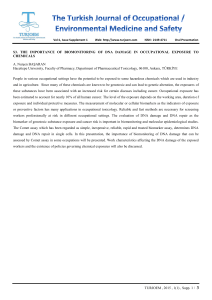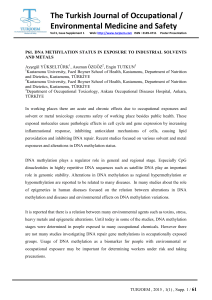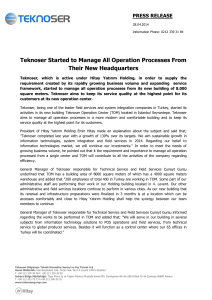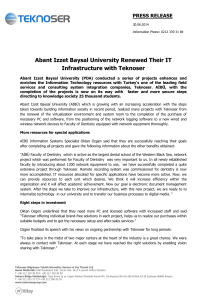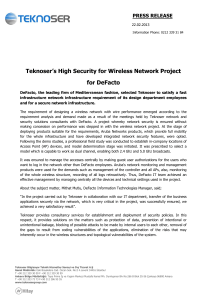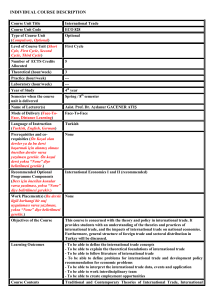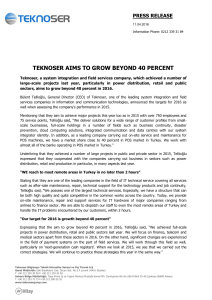Uploaded by
common.user18184
News & Environmental Ethics: A Critical Approach
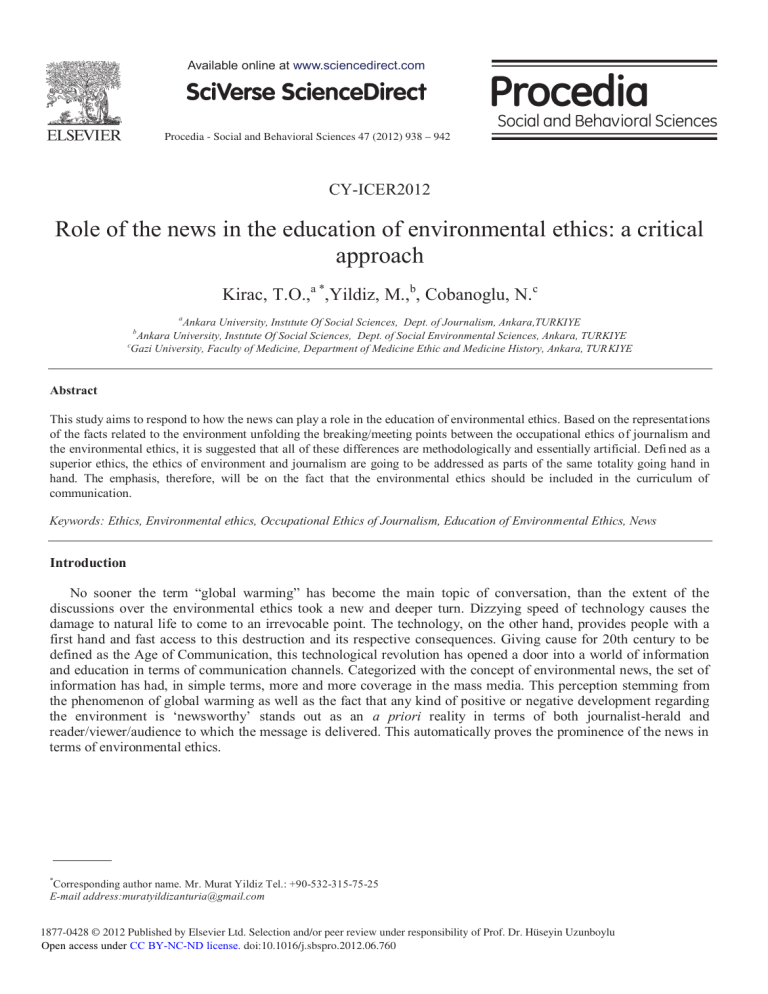
Available online at www.sciencedirect.com Procedia - Social and Behavioral Sciences 47 (2012) 938 – 942 CY-ICER2012 Role of the news in the education of environmental ethics: a critical approach Kirac, T.O.,a *,Yildiz, M.,b, Cobanoglu, N.c a Ankara University, Instıtute Of Social Sciences, Dept. of Journalism, Ankara,TURKIYE Ankara University, Instıtute Of Social Sciences, Dept. of Social Environmental Sciences, Ankara, TURKIYE c Gazi University, Faculty of Medicine, Department of Medicine Ethic and Medicine History, Ankara, TURKIYE b Abstract This study aims to respond to how the news can play a role in the education of environmental ethics. Based on the representations of the facts related to the environment unfolding the breaking/meeting points between the occupational ethics of journalism and the environmental ethics, it is suggested that all of these differences are methodologically and essentially artificial. Defi ned as a superior ethics, the ethics of environment and journalism are going to be addressed as parts of the same totality going hand in hand. The emphasis, therefore, will be on the fact that the environmental ethics should be included in the curriculum of communication. Keywords: Ethics, Environmental ethics, Occupational Ethics of Journalism, Education of Environmental Ethics, News Introduction No sooner the term “global warming” has become the main topic of conversation, than the extent of the discussions over the environmental ethics took a new and deeper turn. Dizzying speed of technology causes the damage to natural life to come to an irrevocable point. The technology, on the other hand, provides people with a first hand and fast access to this destruction and its respective consequences. Giving cause for 20th century to be defined as the Age of Communication, this technological revolution has opened a door into a world of information and education in terms of communication channels. Categorized with the concept of environmental news, the set of information has had, in simple terms, more and more coverage in the mass media. This perception stemming from the phenomenon of global warming as well as the fact that any kind of positive or negative development regarding the environment is ‘newsworthy’ stands out as an a priori reality in terms of both journalist-herald and reader/viewer/audience to which the message is delivered. This automatically proves the prominence of the news in terms of environmental ethics. * Corresponding author name. Mr. Murat Yildiz Tel.: +90-532-315-75-25 E-mail address:muratyildizanturia@gmail.com 1877-0428 © 2012 Published by Elsevier Ltd. Selection and/or peer review under responsibility of Prof. Dr. Hüseyin Uzunboylu Open access under CC BY-NC-ND license. doi:10.1016/j.sbspro.2012.06.760 Kirac, T.O. et al. / Procedia - Social and Behavioral Sciences 47 (2012) 938 – 942 939 Any development regarding the environment, regardless of the perspective, is considered as newsworthy paving the way for this perception to be situated in a level of social reality. 1. Environment and Communication The news, in simplest terms, gives information and presents current events to society. Girgin, (2000:73) defines helps them make it through the negativities and threats of the outside world. The information delivered to the reader/viewer/audience, in that case, needs to be for the benefit of him/her. The developments regarding the environment have more and more coverage since these events are considered as more significant than daily The mass media features some of the daily events within the daily flow of life much more than the others. It is represented in the media as defined in the discourse of communication literature. The fact that an event is more newsworthy than the other takes place in a comprehensive process. The public interest of this process comes into forefront within the scope of this study. The most important characteristics of the news is its relation with public principle of public interest that the environmental news has more and more coverage in the media. Release of what is going on in the nature prioritizes the public interest and points at a critical level in terms of occupational ethics since what's going on in the nature directly have an impact upon people. t of information. This approach, within the axis of constraints as a result of occupational practices, puts across a critical look at the representation of the respective 'event' in the media. The setbacks ranging from the tone, organizational setting and ways of access to a news-source and to time and place constraints pose an obstacle before the representation of social reality. This is exactly where the herald is in need of the occupational ethics. The reality needs to be rebuilt since the social reality must be presented through an agent that is to say a herald. The herald resorts to the occupational ethics in order for this building to be as close as possible to the reality. It is believed that this building is the best and true representation of the reality according as the occupational ethics is put into practice in an accurate and complete fashion. The representation of the social reality, in that case, is directly associated with the ethics. 2. Press Ethics vs. Environmental Ethics Despite the fact that the environmental news has more coverage in the mass media since the developments regarding the environment are of more importance for public interest, it is hard to say that this always provides with a perspective complying with the environmental ethics. It is actually safe to say that contradictions have coverage more frequently. Environmental news considered as newsworthy - is represented solely in terms of their breaking regardless of the fact that the development subject to the news is positive or n given in the analysis of respective news texts. A news-story published in the newspaper Milliyet with a headline ''The northern part of the lake will revive'' is a fine instance for this contradictory situation. The news is about the Lake Sapanca, one of the important fresh water resources having a rich ecosystem. The news focuses on the substantial financial gain that large-scale construction investors would have in the northern part of the lake. A construction activity stands for the degradation of the natural cycle by human touch even in the friendliest initiative. In this case, the environmental ethics seems to be contradicting with the occupational ethics of journalism. It is, however, possible to identify from occupational practices point of view that the main problem results from the non-execution of the occupational ethics. One of the pillars for the occupational ethics of journalism is to provide with equal representation of elements subject to the 940 Kirac, T.O. et al. / Procedia - Social and Behavioral Sciences 47 (2012) 938 – 942 news. This news, however, ignores the occupational practice. The representation in the news is an economic approach overleaping the environmental ethics. guide human attitudes against the nature (Des Jardins, 2006:46). The environmental ethics, in other words, is basically a set of information with regard to how the attitudes against the nature should be and be shaped. The abovementioned news includes elements contradictory to both occupational and environmental ethics with an economic reductivism. News about the endangered species is the most dramatic instance in this regard. Televising the Caracal caracal, an endangered species with a decreasing population in the Anatolia, with the help of a photo snapper is a significant and gladsome development. Troubles with the way the news is reported, however, give themselves away. The detailed coverage of the place this species is seen almost unfolds the address of its natural habitat for especially poachers and malicious people. Only 10 percent of the peasants in the Anatolia is aware of this rare species good at hiding. In the same vein, it would not be exaggerative to say that another news reporting about the list of fines to be paid in case of hunting the protected species is far from being disincentive and provides a service for tariff. This leads to contradiction with environmental ethics in terms of representations since either occupational ethics is partly executed or the occupational ethics is completely ignored. The environmental and press ethics, as is seen, should be handled as the non-conflicting and matching parts of a whole. The difference is artificial to develop conceptual sets on a methodological level. The analysis of the abovementioned news proves that the antinomic setting of these two concepts basically results from the partial, imperfect or complete ignorance of the occupational ethics. This analysis requires the concept of ethics to be reconsidered in its own discourse. The methodological differences such as environmental ethics or occupational ethics of journalism remind us that a concept of superior ethics lies behind the antinomic settings. This body, in which all branches of ethics blossom, addresses the totality encapsulating the environmental and press ethics. 3. News as an Educational Opportunity Girgin (2000:105 et al.) points out that the news can be educative when handled as the most effective media content. The tendency to take phenomena presented in the news as directive and truth turns the news into a means with a crucial importance in terms of the education of ethical values. The education of environmental ethics calls for a certain level of individual and collective awareness in the society. No matter what approach the environmental ethics is handled with, being able to display the ethical attitude as a voluntary choice at every turn depends on raising this awareness since it is based on fact that the ethical attitude is a way of life which is given a thought to and adopted. Otherwise, the consideration of a natural value as a consumption object with a perspective totally degraded to economism will be tantamount not only to an attitude contradictory to environmental ethics but also to eradication of the ethical concept. The mass media has played a key role in contributions to the education since its inception even though it is not considered as a direct means of education. Extensity of the mass media, in parallel with technological developments, enables the news to be delivered in a fast, easy and cost-efficient fashion. It would not be wrong to say that the news would be an incomparable agent considering the fact that it is the most effective content of such an influential mechanism. Can You Teach Environmental Philosophy Without Being an Environmentalist?'' This question can find its answer if the hypothesis of Taylor is followed. Taylor (2011) puts stress on the necessity to adopt the respect to nature as a final attitude. This stress should be individually and socially comprehended. Turning the individual awareness about the environmental ethics into a social phenomenon can only be achieved through the mass extensity of that message. The mass media provides the environmental ethics with the mediation service. Criticism pertaining to the fact that this approach is instrumental is legitimate to some extent. The function of the news as an information proves that it also has an ontological potential as a means of education. The point of Kirac, T.O. et al. / Procedia - Social and Behavioral Sciences 47 (2012) 938 – 942 941 education is to provoke rational thoughts. Information is the object of this action. The news as a means of education is autogenous. The news fulfills its function since the information presented is mostly taken as truth even if the news is not made for educational purposes. It would not be utopian to foresee that it would give much faster and effective results thanks to its extensity and accessibility when directly designed for this purpose. 4. Conclusion and Suggestions In conclusion, the news has a major potential in terms of education of environmental ethics. As emphasized before, the environmental ethics and occupational ethics of journalism should be considered as two parts of the same totality. The education, on its own, is a way of thinking that is to say raising an awareness. The news, as the most extensive and accessible means of information, provides with a unique opportunity in the education of environmental ethics since it requires a certain level of awareness and it is possible to reach to that level of awareness on the basis of information. Expansion of the course modules regarding the ethics in the journalism departments of the increasing number of communication faculties in a way to encapsulate the environmental ethics will be the most important step to take. It should not be forgotten that the future heralds are the individuals of a society in which the awareness about the environmental ethics needs to be raised. Embarking on their professions as equipped with this set of information will help them be the user of the most effective and extensive means in terms of the education of environmental ethics. This approach will initially help heralds profess having a desired level of awareness for environmental ethics. An education of ethics in accord with the totality conceptualized with superior ethics rather than environmental and occupational ethics will open the door to raise awareness even in the course of the creation for the most effective content of the media. This sort of educational approach needs to be put into practice as soon as possible since a consistent journalism in terms of environmental ethics complies with the public interest which falls within the basic definition of the profession. 942 Kirac, T.O. et al. / Procedia - Social and Behavioral Sciences 47 (2012) 938 – 942 References Berger, P., & Luckmann, T. (1967). The Social Construction of Reality. USA: A Doubleday Anchor Book. hing Environmental Ethics (pg. 48-62). Netherlands: Brill Leiden. Taylor, P. W. (2011). Respect for Nature (25th Anniversary Edition b.). USA: Princeton University Press. Tuchman, G. (1978). Making News: A Study in the Construction of Reality. UK: Free Press. http://www.milliyet.com.tr/sapanca-belediye-baskani-hakkinda-neden-sorusturma-acilmadi/siyaset/sondakikaarsiv/19.01.2011/1341318/default.htm http://gundem.milliyet.com.tr/sapanca-golu-nde-korkutan-siyah-/gundem/gundemdetay/30.04.2011/1384292/default.htm http://www.milliyet.com.tr/marmaray-dan-cikan-hafriyati-sapanca-golu-ne-doktuler/turkiye/sondakikaarsiv/17.01.2011/1340401/default.htm http://www.milliyet.com.tr/sapanca-icin-ruya-proje/turkiye/sondakikaarsiv/26.11.2010/1318797/default.htm http://hurarsiv.hurriyet.com.tr/goster/ShowNew.aspx?id=15742419 http://hurarsiv.hurriyet.com.tr/goster/ShowNew.aspx?id=18595536
